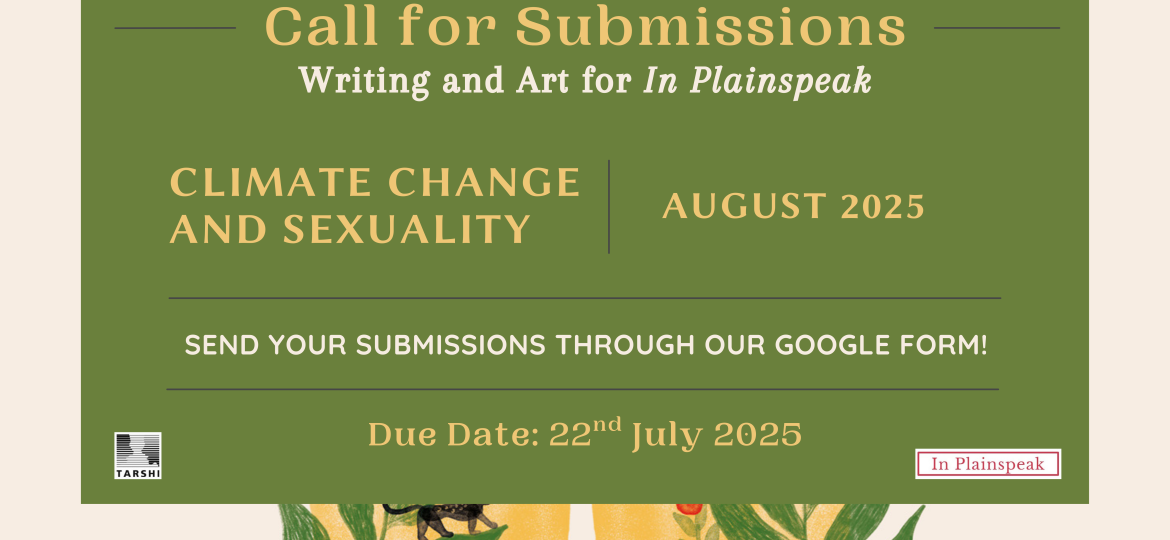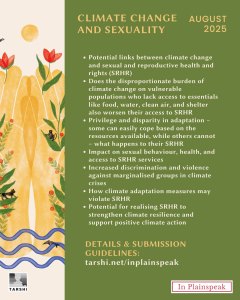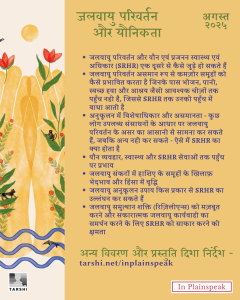
About the theme: Climate Change and Sexuality
Floods, storms and droughts, so-called ‘natural’ disasters, are becoming more common as a result of climate change. Climate change refers to long-term regional and global shifts in temperatures and weather patterns caused largely as a result of human activity, such as the overuse of fossil fuels. Increasing temperatures, rising sea levels, melting glaciers, severe fires, and intense tropical storms are some of the other fallouts of climate change. There are further consequences too, the most brutal – the lack of food, water, clean air and shelter – being felt first by those most vulnerable. Those who like hotter summers and colder winters, some people deal with it by a mere flick of an AC switch. Given where we are situated on the spectrum of privilege, all of us use adaptive mechanisms to cope with major disasters and minor discomforts. Is climate change related in any way to sexual wellbeing and SRHR? How does it affect sexual behaviour? Sexual health and access to SRHR services? Discrimination and violence against already marginalised groups? Do the mechanisms people use to adapt to climate change violate sexual and reproductive rights? Conversely, can the realisation of sexual and reproductive rights build resilience and contribute to positive climate action?
We do not accept AI-generated or AI-modified content. For our detailed submission guidelines, visit: https://www.tarshi.net/inplainspeak/
जलवायु परिवर्तन और यौनिकता
जलवायु परिवर्तन के परिणाम स्वरूप बाढ़, तूफ़ान और सूखे जैसी तथाकथित ‘प्राकृतिक’ आपदाएं, आम होती जा रही हैं। दुनिया भर में और अलग-अलग क्षेत्रों में तापमान और मौसम के रुझानों में दीर्घकालिक बदलावों को जलवायु परिवर्तन कहा जाता है। ये परिवर्तन ज़्यादातर मानवीय गतिविधियों के कारण होते हैं, जैसे कि बहुत ज़्यादा जीवाश्म ईंधन (फॉसिल फ्यूल) का इस्तेमाल करना। बढ़ता तापमान, समुद्र का बढ़ता स्तर, पिघलते ग्लेशियर, भयंकर आग और तीव्र तूफान, जलवायु परिवर्तन के अन्य परिणाम हैं। इसके और भी दुष्परिणाम हैं, जिनमें से सबसे गंभीर हैं – भोजन, पानी, स्वच्छ हवा और आश्रय का अभाव होना – जिसका अनुभव सबसे पहले उन लोगों को होता है जो इसके प्रभावों के प्रति सबसे अधिक संवेदनशील होते हैं। कुछ लोग तपती गर्मी और कड़क सर्दी से जूझते हैं, जबकि कुछ लोग इन सबसे ए.सी. के स्विच के एक झटके से ही निपट लेते हैं। विशेषाधिकार की विस्तृत श्रेणी (स्पेक्ट्रम) पर हम जिस स्तर पर हैं, उसे देखते हुए हम सभी बड़ी आपदाओं और छोटी-मोटी असुविधाओं से निपटने के लिए अनुकूली रणनीतियों का उपयोग करते हैं। क्या जलवायु परिवर्तन किसी भी तरह से यौन खुशहाली (वेलबीइंग) और यौन एवं प्रजनन स्वास्थ्य एवं अधिकार (SRHR) से जुड़ा हुआ है? यह यौन व्यवहार को कैसे प्रभावित करता है? यौन स्वास्थ्य और SRHR सेवाओं तक पहुँच को कैसे प्रभावित करता है? जो समूह पहले से ही हाशिए पर हैं उनके ख़िलाफ़ भेदभाव और हिंसा को कैसे प्रभावित करता है? क्या जलवायु परिवर्तन के अनुकूल होने के लिए लोग जिन तरीकों का इस्तेमाल करते हैं, वे यौन और प्रजनन अधिकारों का उल्लंघन करते हैं? इसके विपरीत, क्या यौन और प्रजनन अधिकारों को प्राप्त करना, समुत्थान शक्ति (रिज़िलीएन्स) पैदा कर सकता है और सकारात्मक जलवायु कार्यवाही में योगदान दे सकता है? इन और अन्य महत्वपूर्ण सवालों पर इन प्लेनस्पीक के इस अंक में चर्चा की जायेगी।
हम AI द्वारा निर्मित या AI द्वारा संशोधित सामग्री स्वीकार नहीं करते हैं। हमारे विस्तृत सबमिशन दिशानिर्देशों के लिए, देखें: https://www.tarshi.net/inplainspeak/
Email your ideas and drafts here
Deadline: 22nd July, 2025



